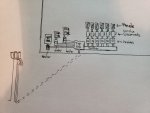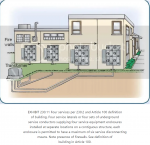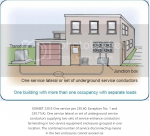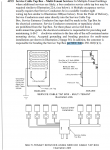JasonCo
Senior Member
- Location
- Houston, Texas
As of Friday, I was lined out on a job that I'm going to be starting Monday. Everything was drawn out and was explained with no confusion, it is cut and dry on what I am suppose to do. I just don't believe this will pass inspection, correct me if I'm wrong.
Here we go. I will have a parallel set of lateral conductors coming from the utility pole and up into a Tap box mounted to the back of a commercial multi-tenant shopping center. I will have a Gutter/trough nipped into the right side of this Tap box. From the tap box I will have 9 separate service entrance conductors going to 9 separate meter cans. All adjacent to one another. 6 of the meter cans will be mounted above the gutter with 6 service disconnects. The other 3 will be separately hard piped on the left side of the tap box and into 3 separate meter cans, and then they will feed into 3 separate panels with main breakers. Everything will be grouped together, all 9.
I'm almost certain this is code violation. You can only have 6 service disconnects grouped together in one "building"/structure/lease space. The other 3 will have to be piped over to a portion of the back wall that is separated by a firewall, because each lease space has a separate address and is separated by a firewall making them their own building/structure.
Only thing I am confused about is if this is okay to do? I'm pretty sure the 9 grouped together is a violation, but is it okay to hard pipe 3 of them off the tap box over to a different "building" and group the other 3 together in that section? Or do I need a totally separate set of service laterals going to the other 3 grouped on the wall in the other "building".
Here is a drawing I made to sort of show you visually what they want. The drawing is horrible, I would not mount my equipment in the way I drew it up haha. It's just to better show what my company wants to do, grouping all 9 together.

Here we go. I will have a parallel set of lateral conductors coming from the utility pole and up into a Tap box mounted to the back of a commercial multi-tenant shopping center. I will have a Gutter/trough nipped into the right side of this Tap box. From the tap box I will have 9 separate service entrance conductors going to 9 separate meter cans. All adjacent to one another. 6 of the meter cans will be mounted above the gutter with 6 service disconnects. The other 3 will be separately hard piped on the left side of the tap box and into 3 separate meter cans, and then they will feed into 3 separate panels with main breakers. Everything will be grouped together, all 9.
I'm almost certain this is code violation. You can only have 6 service disconnects grouped together in one "building"/structure/lease space. The other 3 will have to be piped over to a portion of the back wall that is separated by a firewall, because each lease space has a separate address and is separated by a firewall making them their own building/structure.
Only thing I am confused about is if this is okay to do? I'm pretty sure the 9 grouped together is a violation, but is it okay to hard pipe 3 of them off the tap box over to a different "building" and group the other 3 together in that section? Or do I need a totally separate set of service laterals going to the other 3 grouped on the wall in the other "building".
Here is a drawing I made to sort of show you visually what they want. The drawing is horrible, I would not mount my equipment in the way I drew it up haha. It's just to better show what my company wants to do, grouping all 9 together.





